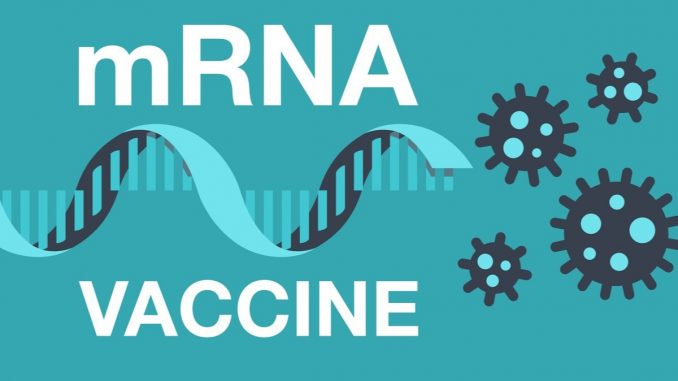
In a recent study published in the Medical Journal of Australia (MJA), researchers described the production, mechanisms, and potential applications of messenger ribonucleic acid (mRNA) vaccines.

Background
mRNA vaccine technology, studied for a long time as a therapy for cancer(s) and to prevent infectious diseases, was implemented rapidly for producing vaccines against severe acute respiratory syndrome coronavirus 2 (SARS-CoV-2). mRNAs are single-stranded molecules containing nucleic acid bases that function as genetic codes for specific proteins. mRNAs are synthesized by the transcription of genes in the cell nucleus and subsequently migrate to the cytoplasm for protein assembly.
mRNA vaccines: technology and synthesis
The mRNA vaccine is designed in silico using the genomic sequences of the target antigen. The mRNA molecule is made using deoxy-RNA (DNA) via in vitro transcription and poly-adenylated at the tail to protect from degradation. The product is purified and assessed for quality and potency, among other characteristics. Although mRNA vaccine could be delivered via different methods, lipid nanoparticles (LNPs) are the preferred delivery vehicles.
Large-scale production of mRNA vaccines could occur in a short time with appropriate facilities. Once delivered into the host cell, ribosomes translate mRNA into the protein of interest. Typically, the protein is expressed on the cell surface to stimulate the cellular immune system. Host cells secrete proteins that other antigen-presenting cells (APCs) capture and present/display for antibody-mediated immune responses.
mRNA vaccine technology: Advantages and limitations
mRNAs are less toxic as cellular processes rapidly degrade them and because they are designed to stimulate the immune system without excessive immunogenicity. Notably, mRNA vaccines are non-infectious, unlike inactivated/attenuated vaccines. Moreover, mRNA vaccines do not use viral vectors for delivery, sometimes resulting in clotting disorders and anti-vector immunity.
From a manufacturing perspective, mRNA vaccines offer several advantages, such as minimal contamination from synthetic material use and in vitro development. Significantly, mRNA vaccines could be expedited for modifications, a critical feature to respond to emerging mutant/resistant (antigenic) variants. mRNA vaccines require cold temperature for storage and transport as they are thermodynamically unstable. This is a serious drawback for settings low on resources for cold chain logistics, for instance, the low- and middle-income countries.
Some safety issues have emerged following the administration of SARS-CoV-2 mRNA vaccines, such as myocarditis and pericarditis, albeit the consequences were mild to moderate and not fatal. Although the mechanism of these events is unknown, it could be antigen-specific or perhaps general to the vaccine itself. Nonetheless, continued surveillance would be critical to the development of newer mRNA vaccines in the future.
mRNA vaccines as prophylactics for infectious diseases
mRNA vaccines could be used prophylactically to prevent infection or disease and therapeutically to augment immunity post-infection/disease. Viruses are ideal targets for prophylactic mRNA vaccination, given their smaller and less complex structures relative to other pathogens (fungi, bacteria, or parasites). Numerous mRNA vaccines are in different developmental phases for viruses like cytomegalovirus, chikungunya virus, influenza virus, rabies virus, and zika virus, among others.
Parasites and bacteria possess multiple antigens, and thus target selection could be challenging. As parasites show a complex reproductive phase, the antigen(s) might not invariably exist on the pathogen. Notwithstanding these limitations, parasitic and bacterial mRNA vaccine candidates have shown promising results in mice models. Additionally, mRNA vaccines are being developed as therapeutics for human immunodeficiency virus (HIV).
mRNA vaccines and cancers
For over two decades, mRNA vaccines have been explored extensively as cancer therapeutics with little success. Lately, the research interest in cancer vaccines has increased significantly, triggered by the durable and dramatic responses observed with immune checkpoint inhibitors in some malignancies and technological advances.
Further, extensive research in the genomic era led to identifying antigens specific to tumors. These neoantigens are unique to individual tumors, representing a customized patient-specific vaccination strategy that has already shown encouraging results. mRNA vaccines are under development for solid tumors, melanoma, prostate, ovarian, breast, and brain cancers. From a clinical viewpoint, it remains to be investigated which setting will benefit more from therapeutic cancer vaccines.
Immunologically hot tumors show high immune cell infiltration and respond well to checkpoint inhibitors; therefore, administering a therapeutic vaccine might not be required to trigger an immune response. On the other hand, using therapeutic vaccines for cold tumors (less/limited immune infiltration) might not be adequate to overcome the immune exclusionary mechanisms observed with these (cold) tumors.
Future directions
The development of mRNA vaccines would continue in the future, galvanized by the success of vaccines against SARS-CoV-2. Further technological advances could minimize the existing limitations and create multivalent vaccines deliverable in a single LNP. Newer strategies should test for incorporating self-amplifying mRNAs, which additionally encode replication machinery and amplify the RNA permitting high expression of the vaccine antigen.
- Overmars I, Au-Yeung G, Nolan TM, Steer AC. mRNA vaccines: a transformative technology with applications beyond COVID-19. Medical Journal of Australia, 2022.
doi:10.5694/mja2.51620 https://onlinelibrary.wiley.com/doi/10.5694/mja2.51620
Posted in: Medical Science News | Medical Research News | Disease/Infection News
Tags: Antibody, Antigen, Bacteria, Bases, Brain, Cancer, Cell, Cell Nucleus, Chikungunya, Cold, Cold chain, Contamination, Coronavirus, Coronavirus Disease COVID-19, covid-19, Cytomegalovirus, Cytoplasm, DNA, fungi, Genes, Genetic, Genomic, HIV, Immune Response, Immune System, immunity, Immunodeficiency, Infectious Diseases, Influenza, Manufacturing, Melanoma, Molecule, Myocarditis, Nanoparticles, Nucleic Acid, Pathogen, Pericarditis, Prostate, Protein, Rabies, Research, Respiratory, Ribonucleic Acid, RNA, SARS, SARS-CoV-2, Severe Acute Respiratory, Severe Acute Respiratory Syndrome, Syndrome, Therapeutics, Transcription, Vaccine, Virus, Zika Virus

Written by
Tarun Sai Lomte
Tarun is a writer based in Hyderabad, India. He has a Master’s degree in Biotechnology from the University of Hyderabad and is enthusiastic about scientific research. He enjoys reading research papers and literature reviews and is passionate about writing.
Source: Read Full Article